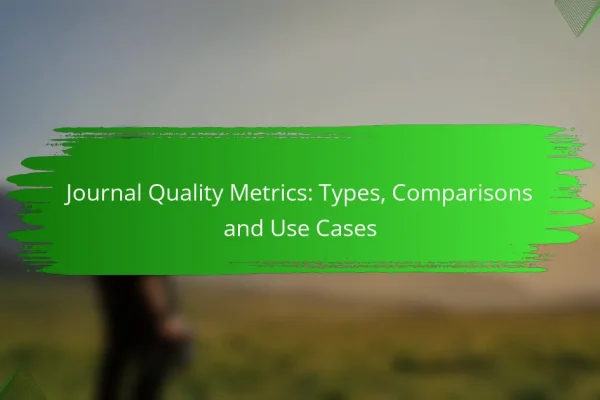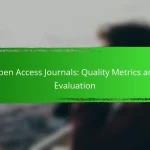How do impact factors affect journal rankings in the UK?
Impact factors significantly influence journal rankings in the UK by measuring the frequency with which articles in a journal are cited. Higher impact factors often correlate with greater visibility and prestige, affecting how journals are perceived within the academic community.
Influence on academic credibility
Impact factors serve as a key indicator of a journal’s academic credibility. Journals with higher impact factors are generally viewed as more reputable, attracting submissions from leading researchers. This can create a cycle where high-impact journals continue to publish influential work, further enhancing their status.
Researchers often prefer to publish in high-impact journals to bolster their own credibility. Consequently, the perceived quality of research can be tied to the journal’s impact factor, influencing how findings are received and cited by peers.
Impact on funding opportunities
Funding bodies in the UK frequently consider the impact factor of journals when evaluating grant applications. Researchers who publish in high-impact journals may have a competitive edge when seeking funding, as these publications are often seen as indicators of quality research.
For example, a study published in a journal with a high impact factor may be more likely to attract funding compared to one in a lower-ranked journal. Researchers should aim to align their publication strategies with the expectations of funding agencies to enhance their chances of securing financial support.
Role in career advancement
Impact factors play a crucial role in career advancement within academia. Promotions, tenure decisions, and hiring processes often weigh heavily on the publication record of candidates, particularly the journals in which they publish.
Academics are encouraged to prioritize publishing in high-impact journals to improve their career prospects. This focus can lead to increased visibility and recognition, which are essential for building a successful academic career in the competitive landscape of UK higher education.
What are the top impact factors used in UK journal rankings?
The top impact factors in UK journal rankings include metrics like Journal Citation Reports (JCR), Scimago Journal Rank (SJR), and Eigenfactor Score. These metrics help assess the influence and quality of academic journals, guiding researchers in selecting where to publish their work.
Journal Citation Reports (JCR)
Journal Citation Reports (JCR) is a widely recognized tool that evaluates journal impact based on citation data. It calculates the Impact Factor, which reflects the average number of citations received per paper published in a journal during a specific period, typically two years.
When using JCR, consider that a higher Impact Factor often indicates a more influential journal, but it can vary significantly across disciplines. For instance, journals in the sciences may have higher Impact Factors than those in the humanities.
Scimago Journal Rank (SJR)
The Scimago Journal Rank (SJR) measures journal impact by considering both the number of citations and the prestige of the citing journals. This metric is calculated based on Scopus data and provides a broader view of journal influence compared to traditional metrics.
One advantage of SJR is that it accounts for the quality of citations, meaning that citations from highly regarded journals carry more weight. This can be particularly useful for researchers looking to publish in reputable journals within their field.
Eigenfactor Score
The Eigenfactor Score evaluates journals based on the number of citations received, adjusted for the source of those citations. This metric emphasizes the importance of citations from influential journals, providing a comprehensive view of a journal’s impact.
Eigenfactor Scores are beneficial for comparing journals across different fields, as they normalize citation patterns. Researchers should consider this score alongside other metrics to get a well-rounded perspective on journal quality.
How can researchers improve their journal rankings?
Researchers can enhance their journal rankings by strategically targeting high-impact journals, refining their citation practices, and collaborating with established authors. These approaches can significantly influence visibility and credibility within the academic community.
Target high-impact journals
Selecting high-impact journals is crucial for improving rankings. These journals typically have rigorous peer-review processes and a broad readership, which can amplify the reach of your research. Aim for journals with high impact factors relevant to your field.
Consider the scope and audience of the journal to ensure alignment with your research topic. Tools like Journal Citation Reports can help identify suitable high-impact journals.
Enhance citation practices
Improving citation practices can lead to higher visibility and better rankings. Ensure that your work is well-cited by referencing influential studies and encouraging others to cite your research. This can be achieved by sharing your work on platforms like ResearchGate or social media.
Utilize citation management tools to track and manage your references effectively. Aim for a balanced citation strategy that includes both foundational and recent studies in your field.
Collaborate with established authors
Collaborating with established authors can enhance your credibility and increase the likelihood of publication in high-ranking journals. These authors often have a strong network and experience navigating the publication process.
Seek opportunities for co-authorship on projects or papers. This can also provide mentorship and insights into effective writing and submission strategies that align with high-impact journals.
What criteria should be considered when selecting a journal?
When selecting a journal, consider factors such as alignment with your research scope, the speed of the review process, and open access options. These criteria can significantly impact your publication experience and the visibility of your work.
Scope and audience alignment
Ensure that the journal’s scope aligns with your research topic and intended audience. A good fit increases the likelihood of acceptance and ensures your work reaches the right readers.
Review the journal’s aims and scope on its website to confirm it caters to your field. For instance, if your research is in environmental science, target journals that focus specifically on ecological studies or sustainability.
Review speed and publication frequency
Consider the review speed and how often the journal publishes issues. Some journals may take several months to review submissions, while others might have a quicker turnaround of a few weeks.
Check the journal’s website for average review times and publication schedules. If timely publication is critical for your research, look for journals that publish frequently, such as monthly or quarterly.
Open access options
Investigate whether the journal offers open access options, which can enhance the visibility and accessibility of your work. Open access journals allow anyone to read your research without subscription barriers.
Be aware that many open access journals charge article processing fees, which can range from a few hundred to several thousand dollars. Weigh the benefits of increased exposure against the potential costs when making your decision.
What are the limitations of impact factors in journal rankings?
Impact factors have several limitations that can distort the evaluation of journal quality. They primarily focus on citation counts, which may not accurately reflect the true influence or quality of research published in a journal.
Overemphasis on citation metrics
Impact factors heavily rely on citation metrics, which can create a skewed perception of a journal’s value. Journals with high citation counts may not necessarily publish groundbreaking research; they might simply publish more articles that are frequently cited. This overemphasis can lead researchers to prioritize quantity over quality in their publications.
Additionally, citation practices vary widely across disciplines. For instance, fields like medicine may have higher citation rates compared to humanities, making direct comparisons misleading.
Neglect of interdisciplinary research
Impact factors often overlook the significance of interdisciplinary research, which may not fit neatly into traditional citation metrics. Journals that publish interdisciplinary work might receive fewer citations simply because their audience is more diverse and dispersed across various fields.
This neglect can discourage researchers from pursuing innovative, cross-disciplinary studies that could lead to significant advancements. Consequently, valuable research may be undervalued or ignored in rankings based on impact factors alone.
Potential for gaming the system
The reliance on impact factors opens the door for potential manipulation, where journals may engage in practices to artificially inflate their citation counts. This can include publishing numerous review articles or encouraging self-citations, which do not necessarily reflect genuine academic impact.
Researchers and institutions should be cautious of these practices and consider a broader range of metrics when evaluating journal quality. Focusing solely on impact factors can lead to a distorted view of a journal’s true influence in the academic community.
What emerging trends are shaping journal rankings in the UK?
Emerging trends in the UK are significantly influencing journal rankings, with a shift towards more diverse evaluation methods. These trends include the rise of alternative metrics, a focus on transparency, and the impact of preprint servers.
Rise of alternative metrics
Alternative metrics, or altmetrics, are gaining traction as they provide a broader view of a journal’s impact beyond traditional citation counts. These metrics can include social media mentions, downloads, and media coverage, offering insights into how research is being engaged with by the public and the academic community.
For instance, a journal that may not have high citation rates could still demonstrate significant influence through high altmetric scores, indicating active discussions and interest in its published research. This shift encourages journals to diversify their outreach and engagement strategies.
Increased focus on transparency
Transparency in the publishing process is becoming increasingly important, with many journals adopting open practices. This includes open peer review, where reviewer comments are made public, and the availability of data and methodologies to support reproducibility.
Journals that prioritize transparency can enhance their credibility and attract submissions from researchers who value ethical practices. For example, journals that openly share their peer review processes may see a rise in submissions from authors seeking a fair and accountable review system.
Impact of preprint servers
Preprint servers are changing the landscape of academic publishing by allowing researchers to share their findings before formal peer review. This practice accelerates the dissemination of knowledge and can influence journal rankings as early visibility may lead to increased citations once the work is formally published.
In the UK, platforms like arXiv and bioRxiv are popular among researchers, enabling them to establish priority for their findings. Journals that are responsive to preprints and incorporate them into their evaluation criteria may gain a competitive edge in attracting high-quality submissions.






